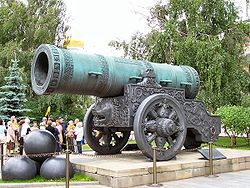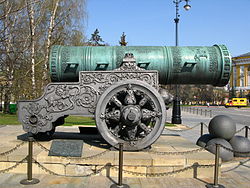- Tsar Cannon
-
Tsar Cannon
Царь-пушка
A view of the Tsar Cannon, showing its massive bore and the Lion's head cast into the carriage.Location Moscow, Russia Designer Andrey Chokhov Type Cannon Material Bronze Length 5.94 metres (19.5 ft) Completion date 1586 Coordinates 55°45′04″N 37°37′05″E / 55.75111°N 37.61806°ECoordinates: 55°45′04″N 37°37′05″E / 55.75111°N 37.61806°E The Tsar Cannon (Russian: Царь-пушка) is a huge cannon on display on the grounds of the Moscow Kremlin. It was cast in 1586 in Moscow, by the Russian master bronze caster Andrey Chokhov. Mostly of symbolic impact, it was never fired in war. Per the Guinness Book of Records it is the largest bombard by caliber in the world,[1] and it is a major tourist attraction in the ensemble of the Moscow Kremlin.
Contents
Description
The Tsar Cannon is located just past the Kremlin Armory, facing towards the Kremlin Senate. The very low ratio between its calibre and the length of its barrel makes it technically not a cannon, but a stylized mortar. The Tsar Cannon is made of bronze and weighs 39.312 tonnes[2] and has a length of 5.34 m (17.5 ft).[3] Its bronze-cast barrel has a diameter of 890 mm (35.0 in),[3] and an external diameter of 1,200 mm (47.2 in).[3] The barrel has four cast rectangular brackets for use in transporting the gun, which is mounted on a stylized cast iron gun carriage with two wheels. The barrel is decorated with relief images, including an equestrian image of Tsar Fyodor Ivanovich.
The spherical cast-iron projectiles located in front of the cannon - each of which weighs 1.97 tons, were produced in 1834 as a decoration. They are too large to have been used in the Tsar Cannon, which would have fired 800 kg stone grapeshot rather than cannonballs. [4] According to legend, the cannonballs were manufactured in St. Petersburg, and were intended to be a humorous addition and a symbol of the friendly rivalry between Moscow and St. Petersburg.
History
By the 16th century, bronze casting technology in the Tsardom of Russia was advanced enough to create many artillery pieces noted for their large caliber and rich ornamentation. Artillery was extensively used in the Conquest of Kazan and in numerous other battles. The exact reason why the Tsar Cannon was cast is unknown. The master bronze-caster Andrey Chokhov is known to have resided near today's Lubyanka Square from 1568-1629.
The Tsar Cannon was placed at several points around Moscow in its history. It is known to have been mounted on a special frame with a fixed inclination angle in Red Square near the Place of Skulls in order to protect the eastern approaches to the Kremlin, indicating that it originally did have a practical application. However, by 1706, it was moved to the Kremlin Arsenal and mounted on a wooden gun carriage. It was not used during the French invasion of Russia, although Napoleon Bonaparte considered removing it to France as a war trophy. The wooden gun carriage burnt in the fire that consumed Moscow in 1812, and was replaced in 1835 by the present metal carriage.
In 1860, the Tsar Cannon was moved to its current location on Ivanovskaya Square near the Tsar Bell, which is similarly massive and is the largest bell in the world (but which has never been rung).
The cannon was last restored in 1980. It was thoroughly studied at that time and gunpowder residue was found, indicating that the cannon had been fired at least once.[5]
A replica of the cannon was made in 2002 at the Izhevsk machine-building factory. It was given to the Ukrainian city of Donetsk and now is installed near the Donetsk city administration building.
Gallery
References
- Klein, Mina. The Kremlin: Citadel of History. MacMillan Publishing Company (1973). ISBN: 0027508307
- M.E.Portnov: Carʹ-Puška i Carʹ-Kolokol, Moskovskij Rabočij, Moscow 1990, ISBN 5-239-00778-0
- Tropkin, Alexander. The Moscow Kremlin: history of Russia's unique monument. Publishing House "Russkaya Zhizn" (1980). ASIN: B0010XM7BQ
References
- ^ Super-weapons in the history of mankind (Russian)
- ^ Portnov 1990, p. 20
- ^ a b c Portnov 1990, p. 19
- ^ Andrey Chokhov at subscribe.ru (Russian)
- ^ (Russian) Царь-пушка – вовсе не пушка: Что же стоит в Кремле
See also
- List of the largest cannon by caliber
- Massive Ordnance Penetrator
- Grand Slam bomb
- Soviet atomic bomb project
- Father of all bombs
- Mother of all bombs
- Tsar Bomba
- Tsar Bell
- Tsar Tank
Russian "Tsar" projects - Tsar Bell
- Tsar Bomba
- Tsar Cannon
- Tsar Tank
Categories:- Visitor attractions in Moscow
- Artillery of Russia
- Superguns
- Siege artillery
- 890 mm artillery
- Moscow Kremlin
Wikimedia Foundation. 2010.




